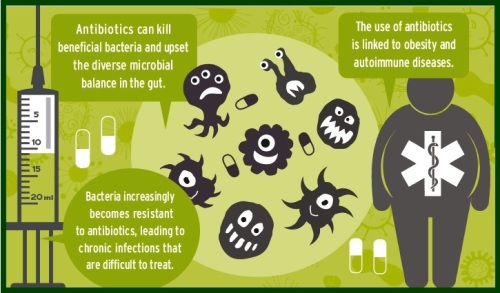 Prebiotics: Better than Probiotics?
Prebiotics: Better than Probiotics?
Many people today are receiving their daily dose of probiotic supplementation or at the very least understand that they probably should be. Less likely are people aware that they should also be receiving a regular supplement of prebiotics.
Prebiotics have numerous health benefits such as improving gut health, inhibiting cancer, enhancing the immune system, and preventing obesity and have shown effective improvements in 91% of all human trials. They have also been shown to reduce symptoms of bowel related issues such as ulcerative colitis, Crohn’s disease, irritable bowel syndrome and celiac disease. (1)
Prebiotics versus Probiotics
Both prebiotics and probiotics nurture the good bacteria required by the digestive tract for proper health beginning at the mouth. Probiotics are live, active cultures capable of multiplying in numbers whereas prebiotics serve as the food source for probiotic and do not grow or reproduce (2).
The difference between probiotics and prebiotics can be learned in a plant analogy. If the intestine is comparable to a flowerbed, probiotics are the individual seeds that you plant. Prebiotics work like fertilizer used to promote growth of the flowers or probiotics. As the flower thrives, it will pollenate and multiple in time.
If you start out with fresh soil containing no flowers, it makes sense that you should first plant seeds and then add fertilizer. The same can be said in regards to creating a healthy intestinal environment for friendly bacteria to flourish. Remember, what purpose does it serve to add fertilizer to a flower bed with limited or no flowers to grow?
Food Sources of Prebiotics
According to regulation standards, prebiotics are made up of nondigestable carbohydrates (fiber) that are used by bacteria in the colon to produce measurable health benefits. Naturally found in food, a prebiotic is not broken down or absorbed by the gastrointestinal tract. Beneficial bacteria use this fiber as a food source in a process called fermentation. (1, 4, 5).
Prebiotics are considered functional foods in that they provide numerous health benefits and aid in the prevention and treatment of diseases and health conditions.
Currently, there are three major types of prebiotics that are well documented: inulin, oligosaccharides and arabinogalactans. Examples of food sources that contain prebiotics are: (5)
- Onions
- Leeks
- Radishes
- Carrots
- Coconut Meat & Flour
- Flax and Chia Seeds
- Tomatoes
- Bananas
- Garlic
- Chicory Root
- Dandelion Greens
- Jerusalem Artichoke
- Jicama
- Asparagus
- Yams
Inulin and oligosaccharides are short-chain polysaccharides, or chains of carbs, which act at different locations in the colon ensuring complete intestinal health. By increasing and maintaining the populations of good bacteria, the body is less susceptible to pathogenic bacteria and yeast that can lead to a diverse range of negative health consequences. (6)
Arabinogalactans are class of long, densely branched high-molecular polysaccharides Many edible and inedible plants are rich sources of arabinogalactans including leeks, radishes, carrots, tomatoes, coconut meat and coconut flour among others. The bark of the larch tree is the best source and often used to make prebiotic supplements.
Human Microbiome Project
The research committed to by The Human Microbiome Project (HMP) discovered an amazing fact. There is 10 times as much DNA found in the bacteria that inhabit our bodies than the number of genes and DNA that complete our own genetic makeup. Since this research, scientists have learned that diversity of bacteria (microbiota) is as unique to each individual as we are physically and genetically different. (8)
The community of bacteria that colonize our digestive tract is referred to as a microbiome. The bacteria in our intestines are of increasing importance because of their critical association with our nutritional needs and health that we are continually learning. The increase of bad bacteria and decrease of friendly bacteria correlate to numerous types of health problems and disease.
Benefits at Every Age:
The benefit of prebiotics starts at conception. Prebiotics are associated with the development of the systemic immune system, or the whole body’s immune function, and benefits babies while they are still in the mother’s womb (7).
Children have shown numerous benefits such as the reduced risk of eczema, an increase in metabolism and growth, and an increased feeding tolerance to dairy by inhibiting the development of allergies. For these reasons and more, prebiotics are now added to infant formula.
An outstanding amount of research demonstrates that prebiotics promote T helper cells which are vital for a healthy immune system. (1, 2, 7, 9)
Improved Systemic Immunity:
Friendly bacteria not only provide the gastrointestinal tract with healthy immunity but they also improve systemic immunity in the entire body. Increased permeability of the intestine in people with leaky gut for instance have a higher risk for pathogens to squeeze through the holes and colonize other organs in the body.
Decreasing inflammation of the intestine and supporting an environment for healthy bacteria to thrive decreases the risk for pathogens to wreak havoc.
Antibiotics Deplete Your Supply:
Antibiotics reduce intestinal microbial populations and may completely deplete some species of friendly bacteria. So after you have a well-nourished flower bed, the dog decides he is going to dig up the flowers and leave gaping holes with missing soil.
These conditions set the stages for pathogenic bacteria to overpopulate and leave you with the negative immune responses you may have previously suffered from (7).
Prebiotics Alleviate Symptoms of IBD
The addition of prebiotics to diet has been shown to decrease inflammatory bowel diseases (IBD). IBD involves the improper regulation of immune response to the community of bacteria in the gut. Those that suffer with IBD are those with Crohn’s disease, ulcerative colitis and celiac disease for example. (7)
Crohn’s Disease: Individuals with Crohn’s disease exhibit symptoms related to inflammation in the small intestine at the start of the colon. People with Crohn’s disease have reduced diversity of good bacteria in their gastrointestinal tract possibly as a consequence of antibiotic treatment (7). As a result, these individuals are more exposed to pathogenic organisms that are drug resistant.
Ulcerative Colitis: Prebiotics have shown significant benefits at alleviating symptoms in those with ulcerative colitis. Individuals will suffer from abdominal pain, urgent bowel movements, bloody stool and other symptoms affected from inflammation of the large intestine. (1)
Celiac Disease: This form of bowel disease is characterized by the chronic inflammatory state of the small intestine triggered by gluten intolerance (9). Americans receive an estimated 70% of prebiotic sources from wheat and 20% from onions (5). Have our diets become so far removed from nature that we have forgotten how delicious other foods are such as garlic and yams?
The immune system in these patients remains on the defense to both good and bad bacteria and fights to prevent any bacterial colonization. Symptoms exhibited include abdominal discomfort, bloody stool, pain in the reproductive tract, and an allergic response in skin.
Celiac disease patients typically have high levels of pro-inflammatory bacteria. In cases where friendly bacteria concentrations are extremely low, individuals with celiac disease may receive some of the greatest benefits from incorporating prebiotics into their diet. (9)
Prebiotics Improve Digestion
Symptoms of IBS (irritable bowel syndrome) can be mistaken for a type of inflammatory bowel disease except that IBS does not cause the chronic inflammatory condition of the gut as might celiac disease. Prebiotic supplementation has been shown to improve the gut microbiome so significantly that symptoms and worsening conditions are less likely.
Prebiotics are a beneficial supplement for everyone because they combat both diarrhea and constipation, prevent IBS and IBD, increase absorption of nutrients such as calcium, and aid the detoxification of intestinal cells (6). Some research even suggest that prebiotics may have roles similar to antioxidants by neutralizing carcinogens while some varieties specifically compete with pathogens.
Prebiotics Prevent Cancers
Prebiotics produce key short chain fatty acids (SFCA’s) such as butyrate, acetate, propionic and valerate. These SFCA’s help to strengthen the gut lining, maintain proper colonic pH and improve energy levels and immune function. The production of SCFA’s helps prevent cancer by:
Reducing Colonic pH: The two most well understood friendly bacteria that colonize the human body are bifidobacteria and lactobacilli (2). These two types of microbiota produce lactic acid which protects the colon by decreasing pH.
A lower pH in the colon reduces colon cancer risk by inhibiting pro-cancer enzymes (6). Lactic acid bacteria also produce short-chain fatty acids such as butyrate. (1)
Increasing Butyrate Levels: Butyrate is one of the best food sources for friendly bacteria as well as for cells that line the intestine (7). Increases in butyrate have been linked to cellular suicide of cancer cells known as apoptosis, and increased concentration of normal cells. Butyrate is also shown to correlate with increases of the antioxidant, glutathione, in colon cells. (6)
Prebiotics Regulate Glucose
Researchers have found that prebiotics taken regularly can limit hunger and reduce risks of type 2 diabetes by maintaining healthy glucose regulation (1). Individuals with diabetes who supplemented their diets with prebiotics had increased amounts of healthy lactobacilli and bifidobacteria and a significant reduction in coliform bacteria. Although coliform bacteria in small amounts may not cause harm, they are also linked to illness and abdominal discomfort.
Whether or not you suffer from blood sugar imbalances, prebiotics can assist in regulating sugar metabolism and may improve your overall health. Studies have shown that prebiotics help control appetite, prevent weight gain and may have a desired laxative effect in newborns without negatively effecting weight gain and development (3).
Prebiotics Control Blood Pressure
One study observed the effects of probiotics and prebiotics on over 6,500 people. Individuals who supplemented their diet with yogurt alone not only had lowered insulin resistance and decreased blood sugar concentrations, but they also had significantly lowered triglyceride levels and blood pressure.
Although further support is still needed, researchers believe that the increase in butyrate inhibits the production of liver cholesterol (6).
A New Topic for Discussion
The term prebiotic was first coined in 1995 and is a relatively new topic for discussion (7). Researchers do not yet have a full understanding of all the health benefits that prebiotics have on the human body.
Some of these studies are beginning to observe that prebiotics may play a role in endocrine or hormone health and may even provide more health benefits to the brain than currently understood (3).

The Synergism of Prebiotics and Probiotics
The combination of prebiotics when taken daily with probiotics has a synergistic health advantage. After all, why would you only plant seeds and not add fertilizer or vice versa? The nutritional supplementation of the two combined is called synbiotics (7).
Some foods that act as synbiotics include kimchii, sauerkraut and pickles. These are all fermented foods that utilize great prebiotic fibers with carrots, cabbage and cucumbers. Radishes are also often used. Herbs like ginger that have prebiotic qualities are often used as well.
Recommendations for Taking Prebiotics
The diversity of every individual’s gut microbiome is as varied as our genetic differences. One major finding of the Human Microbiome Project was that each adult has significantly different varieties of bacteria living in the body (8).
After all, there are too many factors to count that affect the bacteria living within and on us. From the freshness and availability of foods provided to us based on our geographic location to the environmental factors that we were exposed to during our upbringing such as antibiotics, immunizations and whether or not we were fed breast milk or infant formula all play a role in determining the concentration and type of good and bad bacteria.
1. Start Small and Work Up: If you start a prebiotic or probiotic regimen, begin first by taking small doses and gradually increase to the recommended use. This will help you avoid abdominal discomfort or diarrhea that may result.
2. Consume Both Fermented Foods and Prebiotic Foods: Although there are certain circumstances that are best suited for probiotic supplementation, researchers best recommend the combination of both probiotics and prebiotics in your daily diet. Consuming high quality fermented foods such as kimchii, sauerkraut, pickles, etc. is the best way to do this!
3. Snack on Prebiotic Foods: Munch on raw carrots, jicama, cucumbers, flax crackers, berries, apples etc. throughout the day.
4. Digestive Enzymes: Supplementing with digestive enzymes to support healthy digestion may be helpful to you.
5. How Much PreBiotics Should I Consume?: The recommended dose for daily health and wellness is 500-1000 mg/day. Individuals with autoimmune conditions, digestive disorders and food sensitivities may benefit from increased prebiotic concentrated doses. In particular, if your SCFA levels are low than added prebiotics can be especially helpful.
6. PreBiotic Supplements: If taking an oral prebiotic supplement, buy a supplement that contains either arbinoglactans or both inulin and oligosaccharides for optimal effect.
7. Great for Pregnancy: Pregnant and nursing mothers are recommended to take prebiotics because of the known benefits transferred to the baby.
8. Prevents Against Yeast Overgrowth and UTI’s: Maintain a healthy prebiotic supplementation regimen to avoid yeast overgrowth and related urinary tract infections.
* * * * * * *
Re-blogged from http://drjockers.com
THANK YOU DR. JOCKERS FOR ANOTHER GREAT ARTICLE
* * * * * * *
Sources For This Article Include:
- Patel S, and Goyal A. The current trends and future perspectives of prebiotics research: a review. 3 Biotech. 2012 Jun;2(2):115-125. PMCID: 3376865
- International Scientific Association For Probiotics and Prebiotics Link Here
- Hill C, et al. Expert consensus document: The International Scientific Association for Probiotics and Prebiotics consensus statement on the scope and appropriate use of the term probiotic. Nature Reviews Gastroenterology & Hepatology. 2014; 11: 506-514. DOI: 1038/nrgastro.2014.66
- Mayo Clinic: Do I need to include probiotics and prebiotics in my diet? Link Here
- Prebiotin: How Prebiotics Work Link Here
- Meschino Health: Prebiotics (FOS And Other Oligosaccharides): A More Reliable Method To Increase The Gut Friendly Bacteria Link Here
- Preidis GA, and Versalovic J. Targeting the Human Microbiome With Antibiotics, Probiotics, and Prebiotics: Gastroenterology Enters the Metagenomics Era. 2014 July;136(6):2015-2031. PMCID: 41708289
- Turnbaugh PJ, et al. The human microbiome project: exploring the microbial part of ourselves in a changing world. Nature. 2007 Oct;449(7164):804-10. PMC3709439
- Palma GD, Cinova J, et al. Pivotal Advance: Bifidobacteria and Gram-negative bacteria differentially influence immune responses in the proinflammatory milieu of celiac disease. J Leukocyte Bio. 2010 May;87(5):765-778. DOI: 1189/jlb.0709471
Additional Sources Include:
http://www.ccfa.org/what-are-crohns-and-colitis/what-is-ulcerative-colitis/
http://www.ccfa.org/what-are-crohns-and-colitis/what-is-crohns-disease/
http://www.ccfa.org/resources/ibs-and-ibd-two-very.html
http://www.foodinsight.org/Content/3842/Final%20Functional%20Foods%20Backgrounder.pdf
http://www.ccfa.org/resources/antibiotics.html
*******























































































